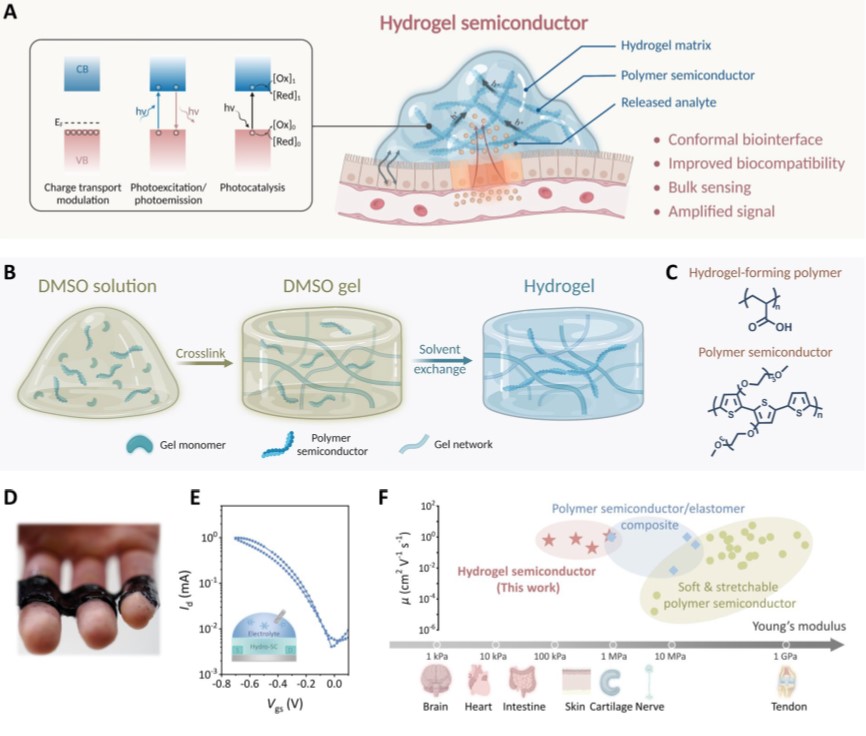SUMMARY
This technology blends a polymer semiconductor with a hydrogel to create a tunable, biocompatible, ultrasoft network that combines efficient charge transport with tissue-like mechanical properties, which are ideal for a variety of bioelectronic devices and sensors.
The Unmet Need: Biocompatible materials with high-performance electronic components
In the field of bioelectronics and soft materials, there is a growing demand for technologies that can seamlessly bridge the gap between rigid electronic components and the soft, dynamic nature of biological tissue. This integration has long been hindered by the inherent mismatch between the hydrophilic nature of soft, tissue-like substrates and the hydrophobic, rigid characteristics of traditional semiconductor materials. Researchers are driven to develop materials that offer both high electrical performance and the mechanical flexibility needed for integration with living systems.
Additionally, achieving a uniform, percolated network of semiconducting domains within a hydrogel matrix is complex due to solubility differences and processing challenges, such as controlling aggregation and maintaining structural integrity during solvent transitions. These issues underscore the ongoing effort to develop fabrication strategies that yield materials combining optimal electronic functionality with the mechanical and biocompatible properties required for advanced bioelectronic applications.
The proposed solution: An innovative interpenetrated network that embeds a water-insoluble polymer semiconductor into a biocompatible hydrogel matrix
This approach is novel compared to existing methods as it overcomes the integration challenges of hydrophobic semiconductors in hydrophilic environments, achieving high mobility, stretchability, and conformability alongside tunable properties such as crosslinking density and semiconductor-to-hydrogel ratio, which enable three-dimensional functionalization and volumetric sensing in bioelectronic devices like high-performance organic electrochemical transistors.
This technology combines a polymer semiconductor with hydrophilic side chains and a hydrogel-forming polymer to create an interpenetrating network. The multi-step process results in a material that features suppressed long-range order with enhanced short-range aggregation, which balances efficient charge transport and high electrical mobility with tissue-like softness and high stretchability. These properties can be finely tunable by adjusting crosslinking densities and component ratios. The precise control over these performance parameters makes it suitable for integrated bioelectronic devices, soft neural interfaces, and high-sensitivity biosensors.
These distinguishing features set it apart from conventional rigid materials, highlighting its potential to drive the next generation of flexible bioelectronics.
FIGURE

Hydrogel Semiconductor (Hydro-SC) for bio-interfaced multi-modal applications. (A) Design of hydro-SC based on interpenetrated double network of a polymer semiconductors and a hydrogel-forming polymer, which enables physically seamless, chemically boundaryless, and immune-compatible interfaces between bio-tissues, as well as the advanced electronic and optoelectronic functions of 5 semiconductors. (B) Preparation method of the hydro-SC, which decouples the gelation step and water swelling step through the solvent exchange. (C) Chemical structures of the utilized hydrogel-forming polymer PAAc and polymer semiconductors p(g2T-T). (D) Photograph showing a prepared hydro-SC conforms on the skin. (E) Hydro-SC film serving as the channel layer in an OECT, giving normal transfer behavior (Vds = -0.8 V). (F) Comparisons of Young’s modulus and 10 charge-carrier mobility from the hydro-SCs (dark red) with other reported soft and stretchable semiconductors.
ADVANTAGES
ADVANTAGES
-
Superior Tissue-Mimicking Softness: Exhibits ultrasoft, tissue-like mechanical properties and high stretchability for seamless biological integration.
-
Enhanced Charge Transport Efficiency: Enables efficient charge transport with high electrical mobility in bioelectronic devices.
-
Volumetric Sensing Capability: Supports three-dimensional functionalization and volumetric sensing, improving biosensing performance.
-
Tunable Electronic and Mechanical Properties: Offers tunable material properties through compositional adjustments, enhancing device optimization.
-
Improved Biointerface Integration: Demonstrates superior conformability and minimal foreign-body response, facilitating improved neural interfaces and soft sensor applications.
APPLICATIONS
- Wearable biosensors
- Neural interface devices
- Tissue-integrated electronics
- Organic electrochemical transistors
PUBLICATIONS
February 26, 2025
Proof of concept
Patent Pending
Licensing,Co-development
Sihong Wang